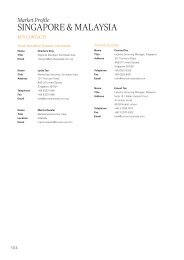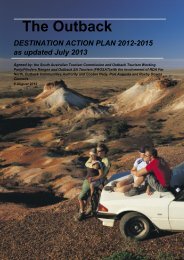Flinders Ranges and Outback Integrated Strategic Tourism Plan
Flinders Ranges and Outback Integrated Strategic Tourism Plan
Flinders Ranges and Outback Integrated Strategic Tourism Plan
You also want an ePaper? Increase the reach of your titles
YUMPU automatically turns print PDFs into web optimized ePapers that Google loves.
Final <strong>Plan</strong><br />
Managing <strong>Tourism</strong> Activities to Protect Ecological Assets<br />
11.0 MANAGING TOURISM ACTIVITIES TO PROTECT ECOLOGICAL ASSESTS<br />
The Environmental Analysis for this project involved an audit of ecological assets from a<br />
tourism perspective. Map 4 shows the biogeographic regions that comprise the <strong>Flinders</strong><br />
<strong>Ranges</strong> <strong>and</strong> <strong>Outback</strong> SA. These are described in the report prepared by Ecological<br />
Associates which is provided in Appendix F of the Companion Document to this <strong>Plan</strong>.<br />
11.1 Key Conservation Assets<br />
The Key Conservation Assets that are potentially at risk from poorly managed visitor<br />
behaviour are:<br />
• Mound Springs<br />
• Arid Rivers <strong>and</strong> Associated Waterholes<br />
• Large freshwater lakes<br />
• Salt Lakes<br />
• <strong>Flinders</strong> <strong>Ranges</strong><br />
• Rangel<strong>and</strong>s<br />
• Coastal Region<br />
Table Five provides a summary of the Ecological Assets in the region <strong>and</strong> the kinds of tourism<br />
activities that would be considered to be appropriate in each ecosystem. Potential impacts<br />
of poorly managed visitor behaviour are noted <strong>and</strong> management responses identified to<br />
minimize the risk of these impacts.<br />
11.2 Management Opportunities<br />
The ecological assets described above are highly sensitive to disturbance but many<br />
opportunities exist for controlling the impacts described in Table 5. Tourist developments such<br />
as shacks or retreats should be designed <strong>and</strong> managed in such a way as to limit disturbance<br />
to native fauna <strong>and</strong> flora. Provision should be made for appropriate disposal of rubbish,<br />
stormwater <strong>and</strong> effluent. Several mound springs, such as the Bubbler <strong>and</strong> Coward Springs<br />
are popular tourist destinations <strong>and</strong> have had on-site works done to reduce impacts, such as<br />
fencing <strong>and</strong> the construction of formalised car parks <strong>and</strong> boardwalks. Similar constructions in<br />
suitable areas could also be undertaken, provided that minimal damage is done to the<br />
natural vegetation <strong>and</strong> plant <strong>and</strong> animal habitat.<br />
Areas containing populations of threatened species or plant communities with a high<br />
conservation priority should be protected <strong>and</strong> the spread of pest plants <strong>and</strong> animals should<br />
be limited.<br />
Impacts from walking, cycling, horse-riding, camel-trekking, cattle-mustering, boating,<br />
camping <strong>and</strong> off-road driving could be managed by directing tourists to properly<br />
Urban & Regional <strong>Plan</strong>ning Solutions<br />
d:\frosa region istp\frosa region istp.doc Page 70





